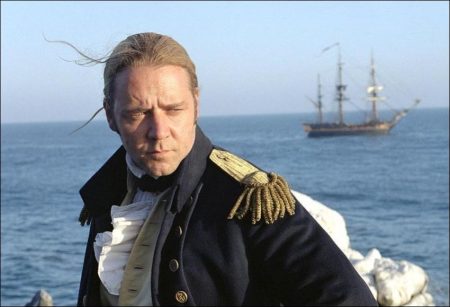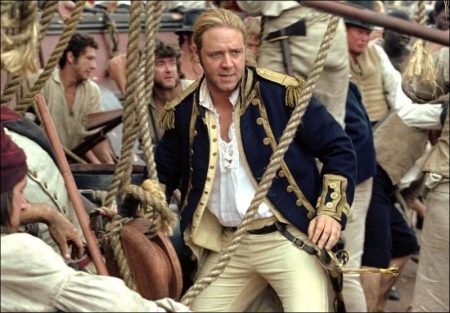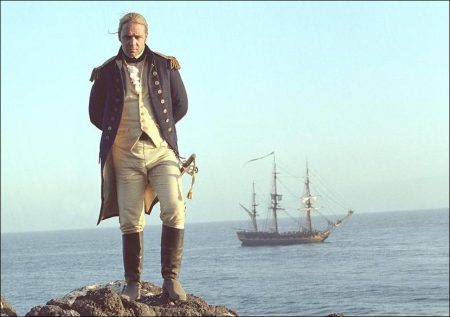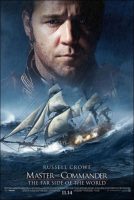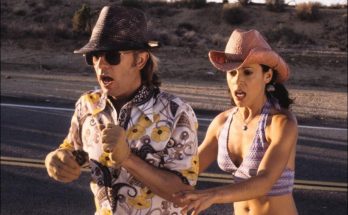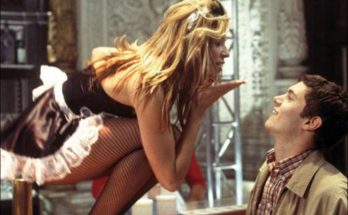Based on the best-selling novels of Patrick O’Brian, the film stars Russell Crowe as “Lucky” Jack Aubrey, who pits his crew of the H.M.S. Surprise against a much better armed and ruthless privateer, in a chase that takes him all the way to the far side of the world. Rising newcomer Paul Bettany plays the ship’s surgeon Dr. Stephen Maturin.
In the course of the characters’ epic journey, the movie travels the world – from the coast of Brazil to the storm-tossed waters of Cape Horn, south through ice and snow, to the far side of the world, to the remote shores of The Galapagos Islands.
Master and Commander is directed by Peter Weir from a screenplay by Weir & John Collee, based upon the novels by Patrick O’Brian. O’Brian’s “Aubrey/Maturin” novels, so named after the lead characters, were declared by Richard Snow, in The New York Times to be “the best historical novels ever written.” David Mamet, also writing in the Times, called O’Brian one of the greatest novelists writing in the English language over the past 30 years. As to O’Brian’s creation, Captain Jack Aubrey, the Times later noted that Russell Crowe “seems born to play him.”
The project originated over ten years ago when two legends – Hollywood producer Samuel Goldwyn, Jr. and celebrated author Patrick O’Brian – had preliminary conversations about turning some of O’Brian’s Aubrey / Maturin stories into a film. It was Goldwyn who first saw the cinematic potential of O’Brian’s work, and he persuaded the author, who had not been to the movies in years, that the medium would well serve the adventures of Captain Jack Aubrey and Dr. Stephen Maturin.
The film that resulted a decade later is based on the principal characters first introduced in O’Brian’s book Master and Commander, but employs the broad narrative outline of the tenth of 20 Aubrey/Maturin novels, The Far Side of the World. Peter Weir believed the latter had a more direct, cinematic and adaptable story structure. (Our heroes are attacked by a superior foe who must be pursued; but how far and at what cost?)
Using the narrative outline from The Far Side of the World also allowed the movie to be concentrated almost completely at sea, a unique and original approach that Peter Weir understood as the key to capturing the spirit and detail of O’Brian’s novels.
The film uses every state-of-the-art motion picture technique and an obsessive attention to accuracy and detail to put the audience back in time – not, as so common now, forward to some science fiction world – and lets us experience an adventure aboard a ship in Nelson’s Navy 200 years ago. From the splinter of wood in an attack to the heat of the doldrums, to rounding Cape Horn in a violent storm, MASTER AND COMMANDER puts the audience at sea as never before in film.
Patrick O’Brian’s 20-volume Aubrey / Maturin opus, which reflected a lifetime of research, was Weir’s touchstone. The director never wavered from his commitment to capturing the detail and spirit of O’Brian’s world and characters, and brings an unprecedented level of historical realism to the film.
As Weir and Collee began writing the screenplay, they marked up O’Brian’s books under the headings: “Divisions,” “Crew,” “Jack and Stephen Dialogue,” and so on. These references were in turn photocopied and turned into books themselves – “handy cribs for cast and crew,” notes Weir.
“I surrounded myself with artifacts of the period as I worked on the script – swords, belt-buckles, maps, hoping to draw down the muse,” Weir continues. “Music was another aid, as I groped in the dark, trying to find my way back in time.”
According to co-screenwriter John Collee, MASTER AND COMMANDER, set largely aboard the ship Surprise, points to Weir’s consummate ability to create vivid, enclosed worlds. “That’s what Peter does brilliantly well, as in Witness and The Truman Show. He wanted MASTER AND COMMANDER to create a floating universe.”
At the core of Patrick O’Brian’s works are the characters of Lucky Jack Aubrey and Dr. Stephen Maturin, and their “study-in-contrasts” friendship. The friendship between Jack and Stephen is one of the most vivid and unexpected in modern literature. They are unique creations and very much the reason there are twenty Aubrey/Maturin novels. Jack is a fusion of the best traits of several real-life captains – a brilliant seaman and genius warrior, if a reluctant follower of orders. He also is exuberant, loud and a connoisseur of bad jokes. Stephen is a brilliant surgeon, naturalist and “lubber” whose courage matches Jack’s.
It took a star with an imposing presence, Russell Crowe, to play the bigger-than-life Jack Aubrey. Much of the magic of O’Brian’s work is pairing the captain with his natural opposite: a man of science whose courage matches Jack’s: Stephen Maturin, played by Paul Bettany.
Peter Weir’s celebrated body of work was a key draw for Russell Crowe. “I’m a longtime fan of Peter’s movies,” says the actor, “and I had always wanted to work with him. I’d grown up with Peter’s movies. For instance, I remember the most terrified I’d been in my young life was being in a cinema watching The Last Wave.”
Crowe was also fascinated with the character of Lucky Jack. “He was a kind of man who doesn’t exist anymore; there’s no template for Jack Aubrey,” says Crowe. “If you are talking about the British Royal Navy as his employer, he is a very unruly employee. However, in the broader sense of the mission with which he is charged as captain, he might not do it the way you want him to do it, but his results at the end of the day will be far more than you intended.”
Weir says Crowe was born to play Lucky Jack. “Russell has a natural energy and authority, and he took command of that ship from the beginning.”
Crowe appreciated some of the perks of “command.” “Every day between my trailer and the set, I would hear ‘Good morning, Captain’ about seventy or eighty times,” says the actor. “Actually, it was difficult giving up the uniform; I’d grown quite fond of it.”
Crowe was pleased to rejoin Paul Bettany who played, memorably, Crowe’s imaginary roommate in A Beautiful Mind. Their collaboration in film proved invaluable in helping the actors create their characters’ relationship in MASTER AND COMMANDER. Says Crowe: “We developed a kind of creative shorthand in A Beautiful Mind that I thought would serve us well in establishing quickly and effectively the Jack-Stephen dynamic. I was so glad that Peter made the decision to cast Paul. There are rhythms and things that we just understand of each other. With another person, you might actually have had to break down a scene and explain it. Paul and I were able to get to a point of depth that you might have to work ten times harder with somebody else to even touch on.”
“It was a joy to watch Paul take the character and make it his own, yet at the same time have it deeply rooted in Patrick O’Brian’s writing,” says Weir. “Russell and Paul are beautifully weighted opposite each other, and you believe they’re friends. It’s as if Maturin, as Paul plays him, is the shape of the modern man and Russell as Jack is from a bygone time.”
Bettany says two elements attracted him to MASTER AND COMMANDER: action and characters. “Any fan of Patrick O’Brian’s books knows them to be real page turners,” says Bettany, “and I see the film as an action movie within which is a richly detailed friendship that endures some life-altering situations. I found that really intriguing.”
Master and Commander: The Far Side of the World (2003)
Directed by: Peter Weir
Starring: Russell Crowe, Paul Bettany, Billy Boyd, James D’Arcy, Lee Ingleby, George Innes, Mark Lewis Jones, Chris Larkin, Richard McCabe, Robert Pugh
Screenplay: Peter Weir, John Collee, Patrick O’Brian
Production Design by: William Sandell
Cinematography by: Russell Boyd
Film Editing by: Lee Smith
Costume Design by: Wendy Stites
Set Decoration by: Robert Gould
Music by: Iva Davies, Christopher Gordon, Richard Tognetti
MPAA Rating: PG-13 for intense battle sequences, related images, brief language.
Distributed by: 20th Century Fox
elease Date: November 14, 2003
Visits: 41
